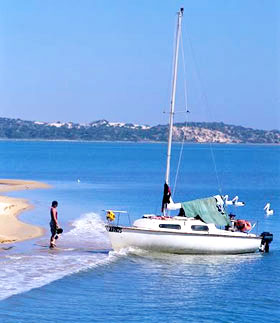![]()
The Limestone Coast: The coastline of South Australia's south-east is known for its diversity of parks and reserves located within a short distance of each other. They vary so dramatically that you could be forgiven for thinking you have travelled to another state or country. Coastal beaches and inland lakes are ideal for water sports of all types, whether it be surfing, swimming, sailing, or scuba diving along the Shipwreck Trail.


The Coorong: The Coorong is a long, shallow lagoon that follows the coast of the south east region of South Australia, south of Lake Alexandrina and the mouth of the Murray River. It is separated from the Southern Ocean by the narrow sand dune of the Younghusband Peninsula. One of the most important wetlands in Australia, the Peninsula and Coorong wetlands are valued for their scenic attributes and accessibility, being only 80 minutes drive from Adelaide. Many parts are used for outdoor recreational pursuits including wildlife observation and studies, sailing and boating of all kinds, sight-seeing, hiking, camping and recreational fishing.

|
![]()
Mount Gambier: A thriving city set in the unique and ancient landscape of volcanic craters, intense blue lakes, sinkholes and mysterious underground waterways, Mount Gambier has become a popular stopover for travellers on their way to and from The Great Ocean Road and the Grampians. But there is far more to Mount Gambier than an overnight stopover can do justice to. An extended stay is necessary to fully appreciate the many natural attractions, both above and below ground, in and around the city.

![]()
Naracoorte Caves: The Naracoorte Caves National Park is South Australia's only World Heritage Site and a premier visitor attraction. The park boasts an extensive range of activities including guided visits to highly decorated caves and significant fossil sites. The Wonambi Fossil Centre presents an insight into the past with life size recreations of extinct Megafauna whilst the Bat Observation Centre and its infra red technology offers a unique view of the otherwise secret world of the Southern Bent-winged Bat.

|
![]()
The Coonawarra: a wine region synonymous with classy Cabernet Sauvignon wines, The Coonawarra owes its wine-making success to its Terra Rossa soil, a red-brown topsoil laid over a thin layer of calcrete (calcium carbonate) sitting on a white limestone base. This soil gives the wine its terrior or flavour of the soil. Black soil areas are interspersed amongst the Terra Rossa and these soils produce quite different wines not dissimilar to those from Bordeaux in France. More than 24 Coonawarra wineries have cellar door sales outlets, mostly open seven days a week (except Christmas Day) for tastings.

![]()
Penola: The service town for the Coonawarra wine region, Penola is also the oldest town in the south-east region of South Australia. It cherishes its historical buildings, which include the remains of a grand old railway station, several slab and hewn cottages from the early 1850s and an old Cobb & Co. stage coach office. But its most famous building is the actual schoolhouse where a young Mother Mary MacKillop founded the Sisters of St Joseph.
Penola is associated with two of Australia's most distinguished poets. John Shaw Neilson was born in the town in 1872, and Adam Lindsay Gordon worked in the area as a mounted policeman from 1853-54.

|